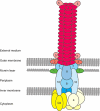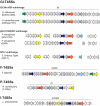Type IV secretion systems: tools of bacterial horizontal gene transfer and virulence
- PMID: 18549454
- PMCID: PMC2688673
- DOI: 10.1111/j.1462-5822.2008.01187.x
Type IV secretion systems: tools of bacterial horizontal gene transfer and virulence
Abstract
Type IV secretion systems (T4SSs) are multisubunit cell-envelope-spanning structures, ancestrally related to bacterial conjugation machines, which transfer proteins and nucleoprotein complexes across membranes. T4SSs mediate horizontal gene transfer, thus contributing to genome plasticity and the evolution of pathogens through dissemination of antibiotic resistance and virulence genes. Moreover, T4SSs are also used for the delivery of bacterial effector proteins across the bacterial membrane and the plasmatic membrane of eukaryotic host cell, thus contributing directly to pathogenicity. T4SSs are usually encoded by multiple genes organized into a single functional unit. Based on a number of features, the organization of genetic determinants, shared homologies and evolutionary relationships, T4SSs have been divided into several groups. Type F and P (type IVA) T4SSs resembling the archetypal VirB/VirD4 system of Agrobacterium tumefaciens are considered to be the paradigm of type IV secretion, while type I (type IVB) T4SSs are found in intracellular bacterial pathogens, Legionella pneumophila and Coxiella burnetii. Several novel T4SSs have been identified recently and their functions await investigation. The most recently described GI type T4SSs play a key role in the horizontal transfer of a wide variety of genomic islands derived from a broad spectrum of bacterial strains.
Figures



References
-
- Backert S, Meyer TF. Type IV secretion systems and their effectors in bacterial pathogenesis. Curr Opin Microbiol. 2006;9:207–217. - PubMed
Publication types
MeSH terms
Substances
Grants and funding
LinkOut - more resources
Full Text Sources
Other Literature Sources

